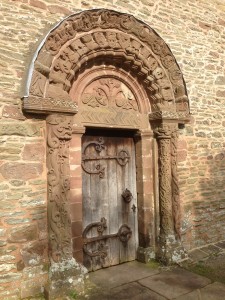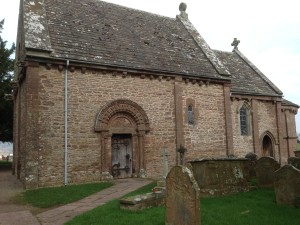In the late spring of 1984 I visited an exhibition at the Hayward Gallery in London. Entitled 1066 – English Romanesque Art 1066-1200, it saw the coming together of some of the great treasures of 12th century England.
The Romanesque style drew inspiration from the arts and crafts of England, Scandinavia, Normandy and other parts of Europe, whilst keeping its feet firmly grounded in the Anglo-Saxon and Celtic vernacular. The outcome, a heady synthesis of many styles, produced an artistic vocabulary that was both distinctive and yet, paradoxically perhaps, quintessentially English.
For me the jewel in that exhibition was The Becket Casket. Perhaps intended as a reliquary casket (or châsse), its inner core is of oak, with enamelled gilt copper panels mounted upon it. The front panel shows the standing figure of Archbishop Thomas Becket being attacked at the altar by three knights, whilst two priests stand to his left, their hands raised in horror.
The casket, made in Limoges around 1180-1190, is of rectangular architectural form, and is constructed of copper alloy, champlevé enamel, crystal and glass, with a wooden core. It is the earliest surviving example of Limoges enamel showing the act of Becket’s martyrdom, which took place in Canterbury Cathedral on the night of 29th December 1170.
Some ten years or so before the Hayward exhibition, when still a student, I bought a copy of Janet and Colin Bord’s fascinating book Mysterious Britain, an essential companion to Alfred Watkins’ seminal The Old Straight Track. In their introduction the Bords quote the author and antiquarian Harold Bayley thus:
“It is, however, an Englishman’s peculiarity that possessing perhaps the most interesting history, and some of the most fascinating relics in the world, he is either too modest or too dull to take account of them”.
In writing, and illustrating with the most tantalising photographs, Mysterious Britain, the Bords achieved their goal of re-awakening in many, a passion for our “fascinating relics”.
One ancient church in particular stood out for me in that book. Kilpeck church, in Herefordshire, they describe as having a doorway that “…carries a variety of symbolic designs, possibly embodying pre-Christian ideas.”
In John Betjeman’s excellent A Pictorial History of English Architecture he describes Kilpeck in enthusiastic terms:
“The far-ranging Normans were able to loot traditional cultures all the way from Northern Europe to Jerusalem, and even in the Herefordshire countryside the village church of Kilpeck (c. 1140) displays a bewildering internationalism in its sculpture. Influences range from Burgundian to North Italian in the figures, to the Viking Ringerike style and Celtic manuscripts in the vivaciously interlaced dragons.”
But it was in his description of another church, that of Barfreston in Devon, which he describes as “…richly wrought as an ivory casket” that he truly captures the essence of the place.
Kilpeck stands, a robust yet diminutive casket of carved stone, within the ancient Herefordshire countryside, and still astounds the eye with the vitality and vivacity of its remarkably well-preserved carvings. Here, cheek-by-jowl, stand carved corbels of the Agnus Dei, dancing musicians, Celtic knots, dogs and rabbits; a startling congregation of the Christian and pagan, the sacred and the profane.
The columns of the doorway proudly sport a vibrant Green Man, and the ingeniously interlaced serpents (tail of one in the mouth of the other) are most likely symbolic of the continuous cycle of life, and therefore true to Celtic belief. Some of the other figures, above the door and amongst the corbels, are taken from The Bestiary, the source of practically all the animal lore that was then available, and include carved images of the fearsome Mantichore and Basilisk.
Perhaps most startling of all is the corbel on the south side of the church, carved to depict the Sheelah-na-gig. To quote the church guidebook, the Sheelah is:
“…a fertility cult figure, a representation of the Great Earth Mother Goddess, a Celtic goddess of creation and destruction, an obscene hag, a sexual stimulant, a medieval Schandbild to castigate the sins of the flesh.”
That this Sheelah, this powerful pre-Christian figure, survived the subsequent purges of the later Christian church, and those fired especially by Victorian prudery, is a wonder and a blessing too.
When you step inside the church, as I did last weekend after so many years of waiting, you enter the body of the casket. There are no reliquaries here now, no rich jewels to fill this châsse, nor any core of oak. Here the heart is of local stone, its form of a pure simplicity and lacking any ostentation. The chancel arch and the rib vaulting of the apse alone show any sign of carving or decoration.
As I stood there in the short nave, looking down through the chancel arch to the vaulted apse, I thought on the Romanesque vivacity of its splendid exterior. I wondered what treasures it once contained, and felt saddened by their loss. And as I placed my hand on the cool stone I understood. I understood that the jewels within the casket are not, never were, of man’s creation; but were and still are born of our receptive spirit.
As Mysterious Britain awoke in me wonderment for our ancient places, so this place, this church, lit within me a deep and spiritual connection with our past. A connection not rooted in religion or superstition, but dredged up from a far deeper certainty; an unbroken, innate and passionate belonging to this land. And that light, which shines brightly from all that are touched by this place, is the lasting jewel within the casket.
See the Becket Casket here: http://collections.vam.ac.uk/item/O80222/the-becket-casket-casket-unknown/



